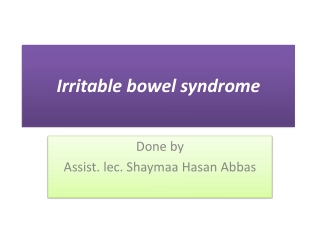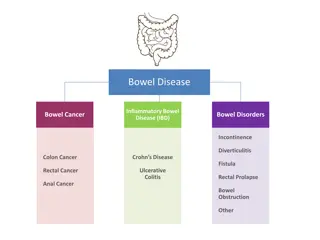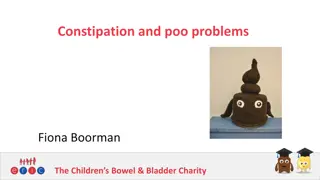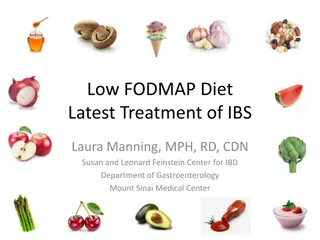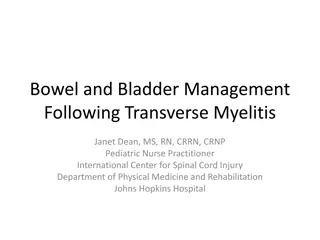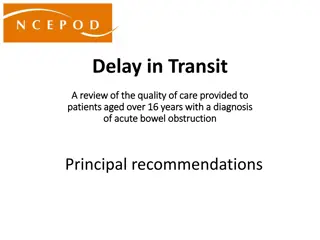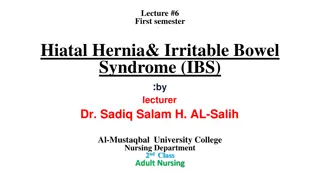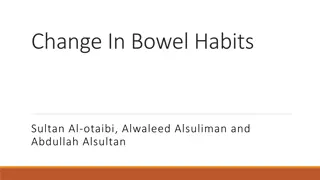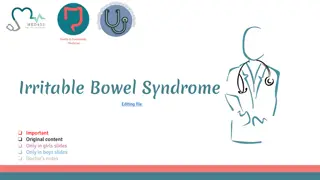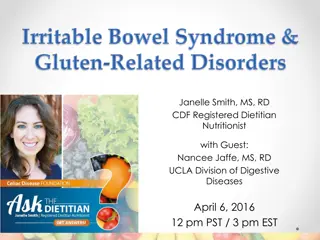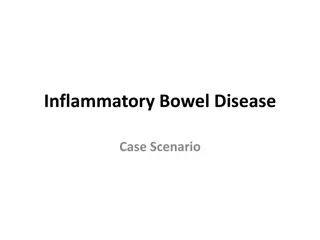Understanding Irritable Bowel Syndrome and Its Pathophysiology
Irritable bowel syndrome (IBS) is a common gastrointestinal disorder characterized by chronic abdominal pain and altered bowel habits. Despite the absence of organic causes, patients experience symptoms such as abdominal distention, bloating, and visceral hypersensitivity. The pathophysiology of IBS involves abnormalities in gastrointestinal motility and heightened sensitivity to stimuli. Understanding these factors is crucial for diagnosing and managing IBS effectively.
Download Presentation

Please find below an Image/Link to download the presentation.
The content on the website is provided AS IS for your information and personal use only. It may not be sold, licensed, or shared on other websites without obtaining consent from the author. Download presentation by click this link. If you encounter any issues during the download, it is possible that the publisher has removed the file from their server.
E N D
Presentation Transcript
DR Othman Alharbi, MBBS FRCPC Assistance Professor & consultant Gastroenterology College of Medicine King Saud University
Objective Understand the hypothesis explain the pathphysiology of IBS. Common sign and symptoms Rome III criteria of diagnosis Introduction to management of IBS
Irritable bowel syndrome Irritable bowel syndrome (IBS): is a gastrointestinal disorder characterized by chronic abdominal pain and altered bowel habits in the absence of any organic cause It is the most commonly diagnosed gastrointestinal condition. The pathophysiologyof IBS remains uncertain. It is viewed as a disorder resulting from an interaction among a number of factors.
Pathophysiology of IBS GASTROINTESTINAL MOTILITY motor abnormalities of the GI tract are detectable in some patients with IBS Abnormalities observed include: increased frequency and irregularity of luminal contractions prolonged transit time in constipation-predominant IBS
VISCERAL HYPERSENSITIVITY Visceral hypersensitivity (increased sensation in response to stimuli) is a frequent finding in IBS patients. Perception in the gastrointestinal (GI) tract results from stimulation of various receptors in the gut wall. These receptors transmit signals via afferent neural pathways to the dorsal horn of the spinal cord and ultimately to the brain.
Distention: Various studies have shown that in patients with IBS, awareness and pain caused by balloon distention in the intestine are experienced at lower balloon volumes compared with controls Bloating : About half of patients with IBS (mainly those with constipation) have a measurable increase in abdominal girth associated with bloating (sensation of abdominal fullness) It is unclear whether heightened sensitivity of the intestines to normal sensations is mediated by the local GI nervous system, by central modulation from the brain, or by some combination of the two
INTESTINAL INFLAMMATION Lymphocytes Increased numbers of lymphocytes have been reported in the colon and small intestine in patients with IBS . increase in lymphocyte infiltration in the myenteric plexus in nine patients and neuron degeneration in six patients . These cells release mediators (nitric oxide, histamine and proteases) capable of stimulating the enteric nervous system, leading to abnormal motor and visceral responses within the intestine.
POSTINFECTIOUS Walkerton, Ontario
ALTERATION IN FECAL MICROFLORA Change in gut microbiota: emerging data suggest that the fecal microbiota in individuals with IBS differ from healthy controls and varies with the predominant symptom Bacterial Overgrowth
FOOD SENSITIVITY PSYCHOSOCIAL DYSFUNCTION Psychosocial factors may influence the expression of IBS.
Clinical feature Younger patients and women are more likely to be diagnosed with IBS. 2:1 female predominance in North America In china male are more common to have IBS
Sign and Symptomes Chronic abdominal pain Altered bowel habits Diarrhea Constipation Other gastrointestinal symptoms Upper gastrointestinal symptoms, including gastroesophageal reflux, dysphagia, early satiety, intermittent dyspepsia, nausea, and non-cardiac chest pain, are common in patients with IBS
DIAGNOSTIC CRITERIA Rome III criteria Recurrent abdominal pain or discomfort at least 3 days per month in the last 3 months associated with 2 or more of the following Improvement with defecation Onset associated with a change in frequency of stool Onset associated with a change in form (appearance) of stool
DIAGNOSTIC CRITERIA Rome IV Criteria for Diagnosing IBS:c Recurrent abdominal pain, on average, at least 1 day/week in the last 3 months, associated with two or more of the following criteria: Related to defecation Associated with a change in frequency of stool Associated with a change in form (appearance) of stool. cCriteria fulfilled for the last 3 months with symptom onset at least 6 months before diagnosis
subtypes of IBS IBS with constipation hard or lumpy stools 25 percent / loose or watery stools <25 percent of bowel movements IBS with diarrhea: loose or water stools 25 percent / hard or lumpy stools <5 percent of bowel movements Mixed IBS hard or lumpy stools 25 percent / loose or watery stools 25 percent of bowel movements Unsubtyped IBS insufficient abnormality of stool consistency to meet the above subtypes
DIAGNOSTIC APPROACH Patients are identified as having a symptom complex compatible with IBS based upon the Rome III criteria Routine laboratory studies (complete blood count, chemistries) are normal in IBS. NO red flag symptoms: Rectal bleeding Nocturnal or progressive abdominal pain Weight loss
Management IBS is a chronic condition with no known cure. The focus of treatment should be on relief of symptoms and in addressing the patient's concerns.
Management Therapeutic relationship Patient education Dietary modification Psychosocial therapies MEDICATIONS: Antidepressant medication
Mast cells Mast cells are effector cells of the immune system. An increased number of mast cells has been demonstrated in the terminal ileum, jejunum, and colon of IBS patients [30,31]. Studies have demonstrated a correlation between abdominal pain in IBS and the presence of activated mast cells in proximity to colonic nerves [31]. (See "Mast cells: Development, identification, and physiologic roles", section on 'Physiologic roles'.) Proinflammatory cytokines Cytokines are proteins that are mediators of immune responses. Elevated levels of plasma proinflammatory interleukins have been observed in patients with IBS [28,32]. In addition, peripheral blood mononuclear cells of IBS patients produce higher amounts of tumor necrosis factor than healthy control


